The preliminary results of a new research report on innovation in manufacturing caught our eye here at MAGNET recently.
In 2010, MIT’s President, Susan Hockfield, launched the MIT Production in the Innovation Economy (PiE) research group to answer the question: “What kinds of production do we need–and where do production facilities need to be located–to sustain an innovative economy?”
The PiE group also worked to answer these questions:
“How do production capabilities here and abroad contribute to sustaining innovation and realizing its benefits within our own society?”
“How did this new global economy of fragmented research, development, production and distribution come into being? And what does this mean for the future of the U.S. economy?”
The group analyzed these questions in relationship to large U.S. corporations, start-ups companies that had achieved commercialization, and small- and mid-sized U.S. manufacturers (referred to as “Main Street Manufacturers”).
In late February, the group released its thought-provoking preliminary report (the final report will be published in the fall).
The report’s conclusion:
“What’s held manufacturing in the United States…was the advantage firms gain from proximity to innovation and proximity to users. Even in a world linked by big data and instant messaging, the gains from co-location have not disappeared.”
Since the U.S. share of the world market has declined from 34 percent in 1998 to 28 percent in 2010, the PiE group identifies a key danger point to be the declining weight of the U.S. in the global economy, even though the output of U.S. high-tech manufacturing is still the largest in the world.
The group also reports it’s fear that “the loss of companies that can make things will end up in the loss of research that can invent them.”
The group’s research revolved around interviews with 255 manufacturing firms around the world. Besides interviewing companies in Germany, China, Japan and other countries, the group interviewed 178 U.S. firms–37 in Ohio alone, the largest number in any single state.
Based on these interviews the PiE group suggests that small- and mid-size manufacturers in the U.S. depend almost entirely on their own internal resources for growth. It concluded that the innovations of “main street” manufacturers in the U.S. did not lead to greater profits or faster growth. This partly due to the absence of what the PiE group called “complementary capabilities” that companies can draw on to supplement their own resources when they seek to develop their new ideas.
Comparing U.S. manufacturers to those based in Germany, they found that:
“German manufacturers do not create new businesses through start-ups (the U.S. model), but through transformation of old capabilities. German manufacturers had not only their own legacy resources, but also access to a rich and diverse set of complementary capabilities in the industrial ecosystem: suppliers, trade associations, industrial collective research consortia, industrial research centers, Fraunhofer Institutes, university-industry collaboratives, and technical advisory committees.”
However, the group did find some U.S. examples of the kind of collaboration that might lead manufacturers to profit more from their innovation efforts. Two of these examples were in Ohio:
- The Timken Company’s collaboration with the University of Akron on a coatings laboratory is cited as a positive model for public/private sharing of research and innovation resources.
- The report also mentions the recently established National Additive Manufacturing Innovation Institute (NAMII) in Youngstown as an encouraging example of risk-reduction and risk-pooling.
In it’s conclusion, the report suggests:
“If we can learn from these ongoing experiments in linking innovation to production, new streams of growth can flow out of industrial America.”
From MAGNET’s perspective, the PiE group’s conclusions about the need for complementary capabilities seem to confirm the propositions underlying our Partnership for Regional Innovation Services to Manufacturers (PRISM. The innovative, growth-oriented companies that participate in PRISM benefit from MAGNET’s formal and informal connections to universities, research centers, government resources, workforce and talent development services and many other resources around the region.
If your company is interested in getting more out of its innovation investment, find out more about PRISM by contacting Linda Barita at 216.391.7766. Or visit the PRISM landing page on MAGNET’s website.
You can read the original post here.

